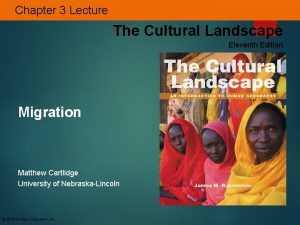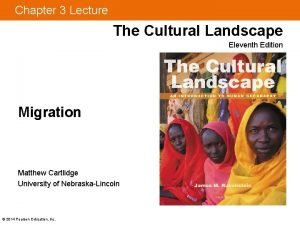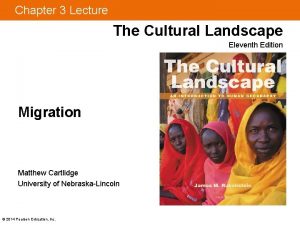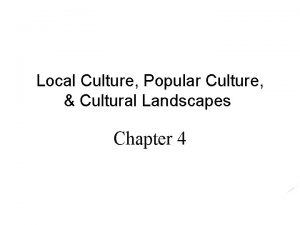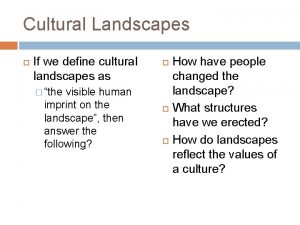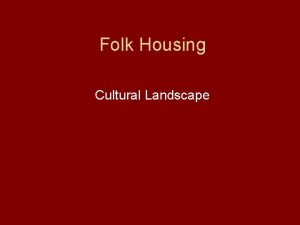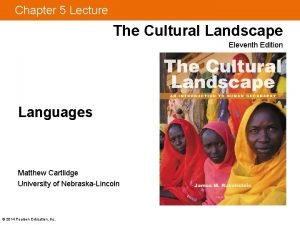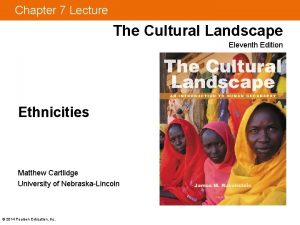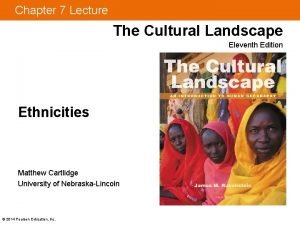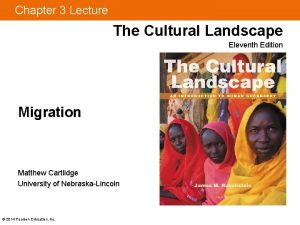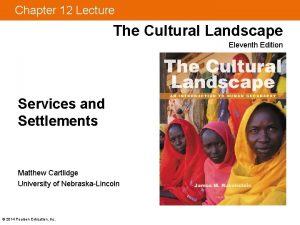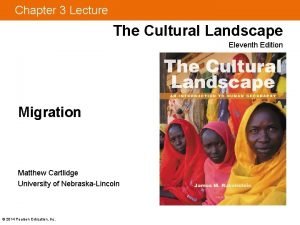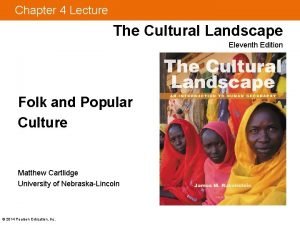Chapter 1 Lecture The Cultural Landscape Eleventh Edition












- Slides: 12

Chapter 1 Lecture The Cultural Landscape Eleventh Edition Basic Concepts Matthew Cartlidge University of Nebraska-Lincoln © 2014 Pearson Education, Inc.

How Do Geographers Describe Where Things Are? • Geography is the study of where things are found on Earth’s surface and the reasons for the locations. • Human geographers ask two simple questions… 1. Where are people and activities found on Earth? 2. Why are they found there? © 2014 Pearson Education, Inc.

Maps • A map is a two-dimensional or flat-scale model of Earth’s surface, or a portion of it. • Cartography is the science of mapmaking. • Maps serve two purposes… 1. As a reference tool to identify an object’s absolute and relative location. 2. As a communications tool to convey the distribution of human activities or physical features. © 2014 Pearson Education, Inc.

Early Mapmaking • Earliest maps were reference tools—simple navigation devices to show a traveler how to get from Point A to Point B. • First world map prepared by Eratosthenes(276– 194 B. C. ) – Improvements to world map later made by Ptolemy. – After Ptolemy, advancements in cartography primarily made outside of Europe by Chinese and Islamic world. • Mapmaking revived during the Age of Exploration and Discovery. © 2014 Pearson Education, Inc.

© 2014 Pearson Education, Inc.

© 2014 Pearson Education, Inc.

Contemporary Mapping • Shift from simply a tool that provides location reference to a tool used by geographers to communicate complex geographic phenomena. © 2014 Pearson Education, Inc.

Map Scale • Level of detail and the amount of area covered on the map depend on its map scale. – Relationship of a feature’s size on a map to its actual size on Earth • Map scale is presented in three ways… 1. Ratio or Fraction Scale: Ex. 1: 24, 000 or 1/24, 000 • © 2014 Pearson Education, Inc. Number on left is one unit of distance, while number on right represents same unit of distance on Earth’s surface.

Map Scale 2. Written Scale: Ex. 1 inch equals 1 mile • Number on left is one unit of distance, while number on right represents a different unit of distance on Earth’s surface. 3. Graphic Scale: Usually consists of a bar line marked to show distance on Earth’s surface • © 2014 Pearson Education, Inc. Distance between two points can be overlaid on the scale bar to determine the distance on Earth’s surface.

© 2014 Pearson Education, Inc.

Projection • Scientific method of transferring locations on Earth’s surface to a flat map is called projection. • Earth’s spherical shape causes distortion when drawing it on a flat piece of paper. – Four types of distortion 1. Shape of an area can be distorted. 2. Distance between points may become increased or decreased. 3. Relative size of different areas can be altered. 4. Direction between points can be distorted. © 2014 Pearson Education, Inc.

© 2014 Pearson Education, Inc.
 Eleventh edition management
Eleventh edition management Management eleventh edition
Management eleventh edition Management eleventh edition
Management eleventh edition Management eleventh edition stephen p robbins
Management eleventh edition stephen p robbins The cultural landscape chapter 3
The cultural landscape chapter 3 The cultural landscape chapter 3
The cultural landscape chapter 3 The cultural landscape chapter 3
The cultural landscape chapter 3 Eleventh 5 year plan
Eleventh 5 year plan Eleventh 5 year plan
Eleventh 5 year plan 11th five year plan
11th five year plan For his eleventh birthday elvis presley
For his eleventh birthday elvis presley Cultural landscape convergence
Cultural landscape convergence What is the meaning of cultural landscape
What is the meaning of cultural landscape




